World War II Aviation Photos
Courtesy Wikipedia, the free encyclopedia.
Edited by David Barth 17 January 2014.
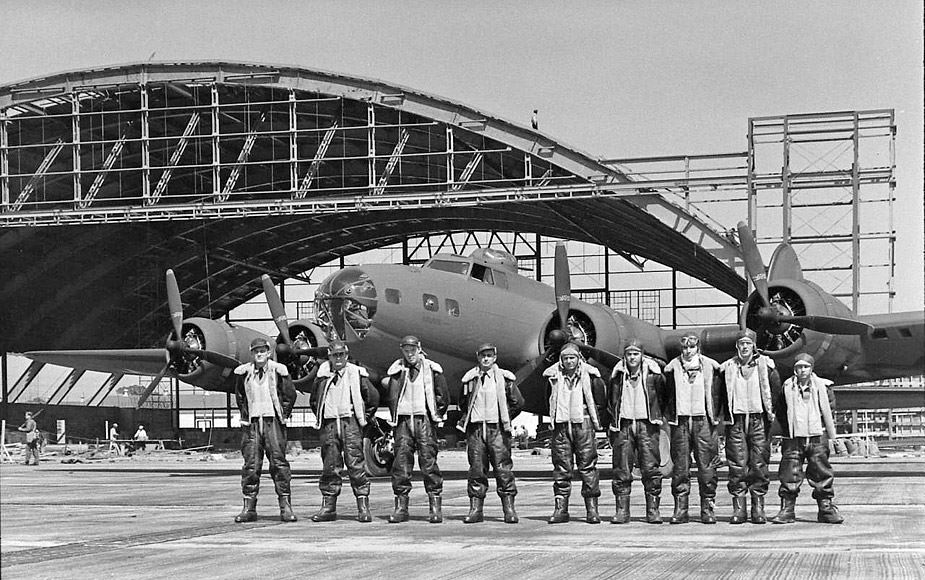 |
| World War II Aviation Photo. |
A crew wearing flight jackets and inflatable life preservers standing in front of a new B-17 that
hasn't had nose art painted on it.
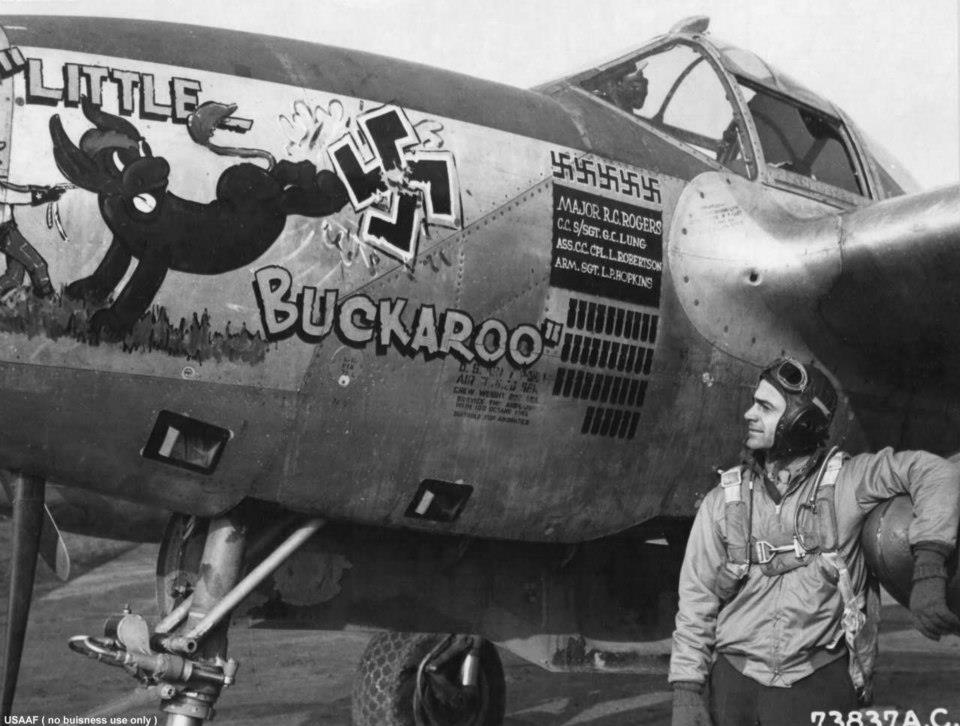 |
| World War II Aviation Photo. |
This is a Lockheed P-38 Lightning twin-engine fighter. The pilot is leaning against a drop
tank that would carry extra fuel for longer range and could be jettisoned when empty or if a dog
fight ensued. The five swastikas painted on the nose indicate he is an ace. Five confirmed enemy
kills were required to become an ace.
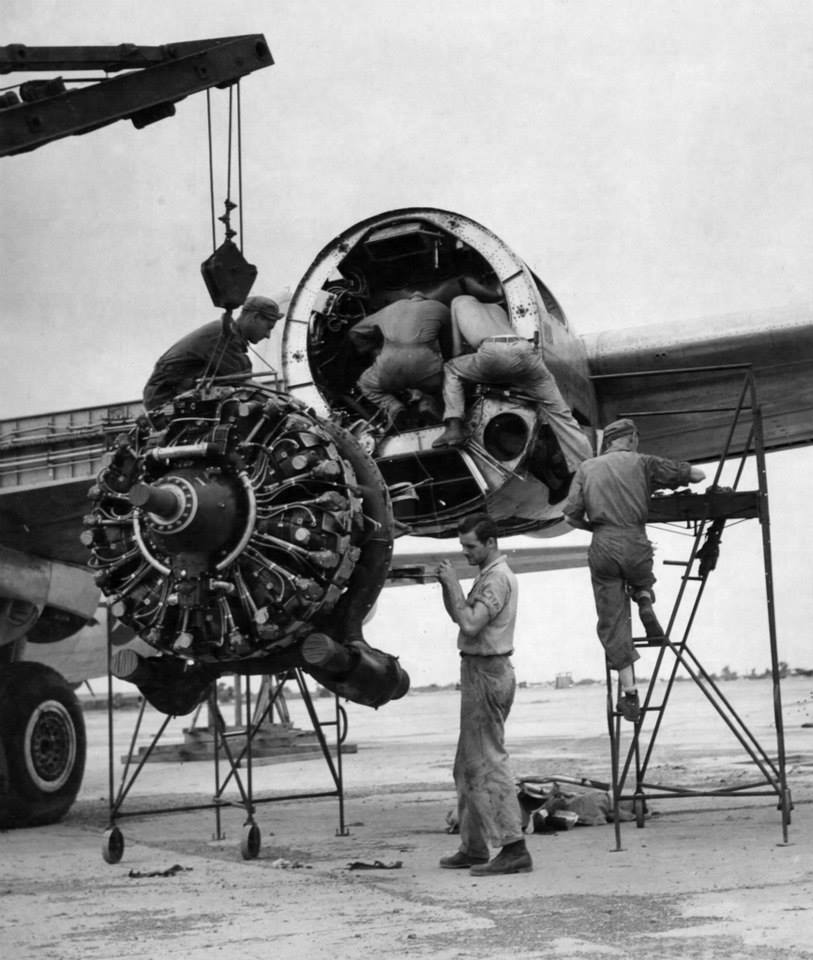 |
| World War II Aviation Photo. |
Changing a radial engine in a bomber. Few fighters used radial engines because they weren't
aerodynamic enough for dog fighting.
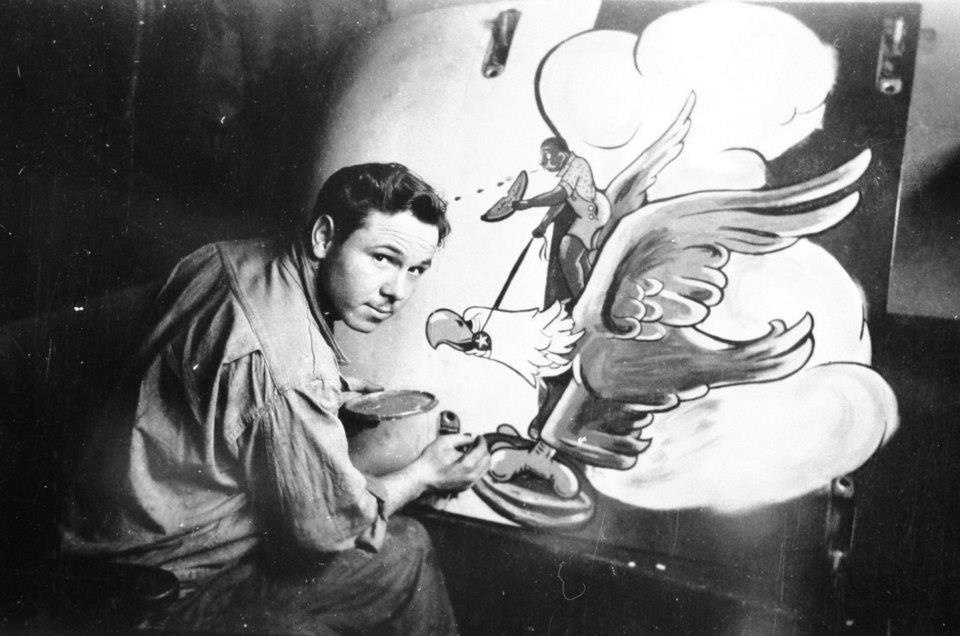 |
| World War II Aviation Photo. |
Here a guy with some artistic talent paints nose art on the nose of an airplane for a black pilot,
perhaps a Tuskegee Airman, from the looks of the picture. The black pilot is spitting watermelon
seeds at the enemy.
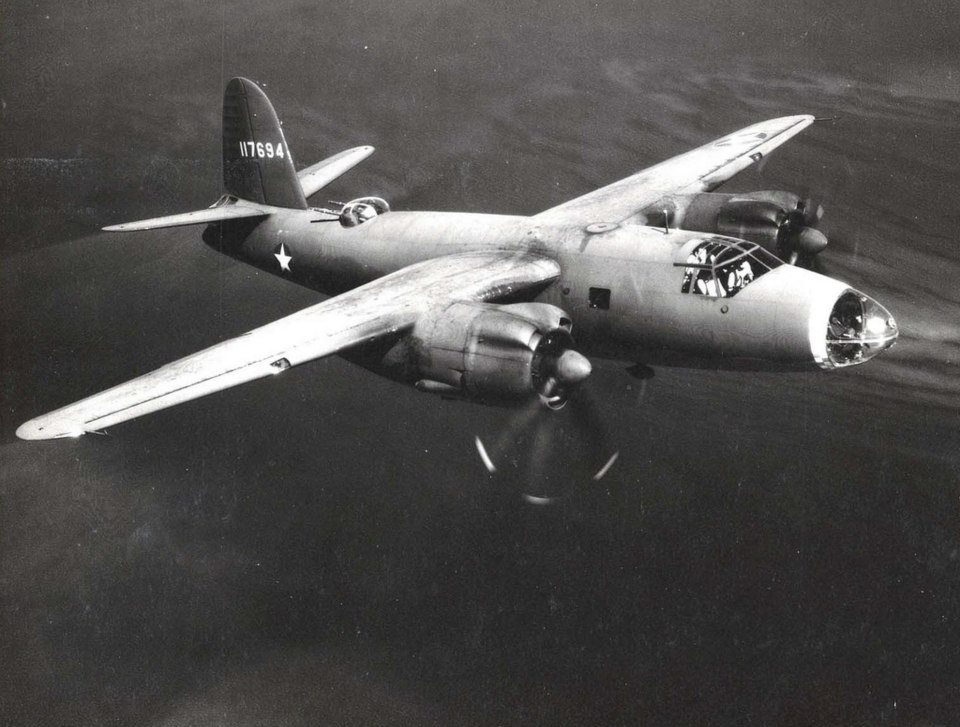 |
| World War II Aviation Photo. |
This is a Martin Marauder. They were very fast but more difficult to fly well.
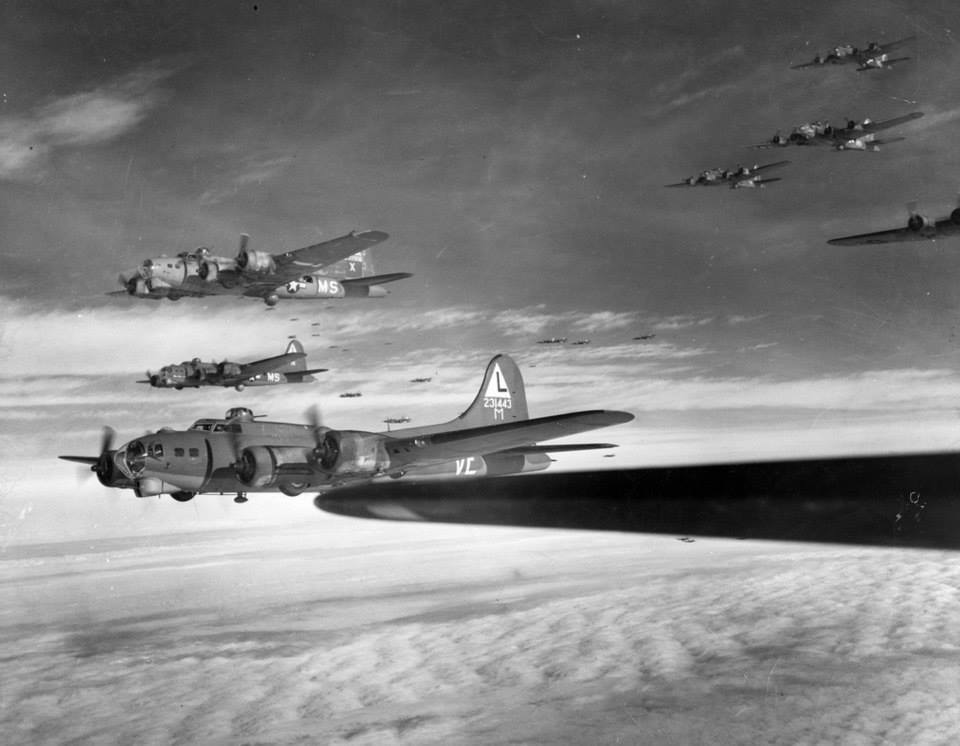 |
| World War II Aviation Photo. |
Formation of B-17 Flying Fortresses.
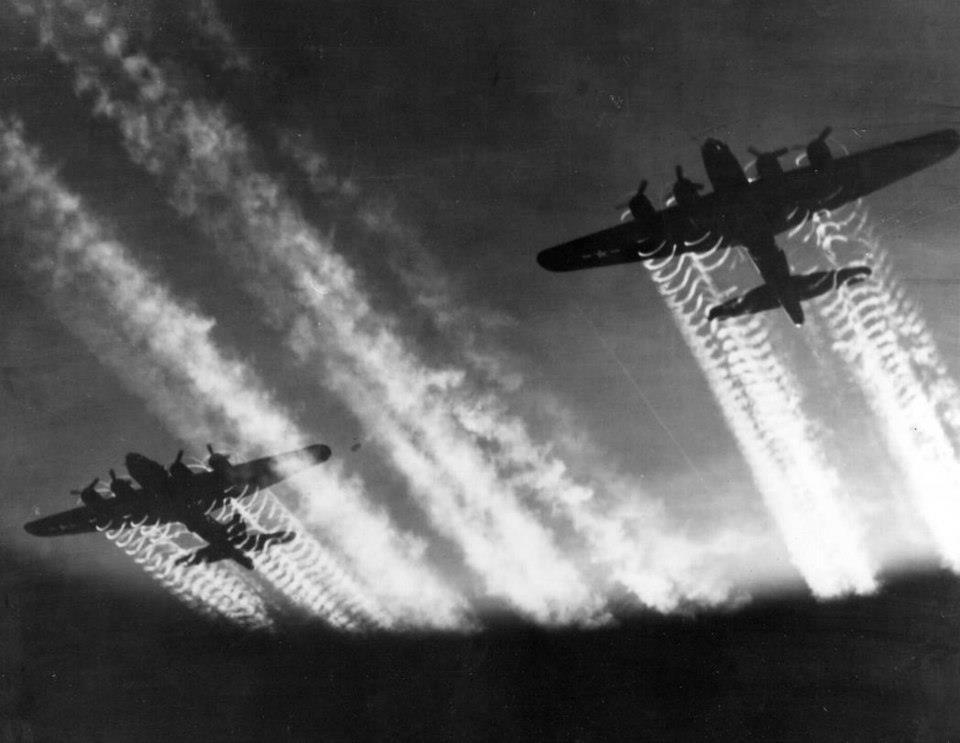 |
| World War II Aviation Photo. |
Formation of B-17 Flying Fortresses at high altitude, probably above 30,000 feet. They are
"conning", creating contrails. The engine heat causes vapor to appear in the air behind the
planes. Contrails were undesirable because they made the planes more visible to the enemy, but in
most cases, that was preferable to flying at a lower altitude that didn't cause contrails.
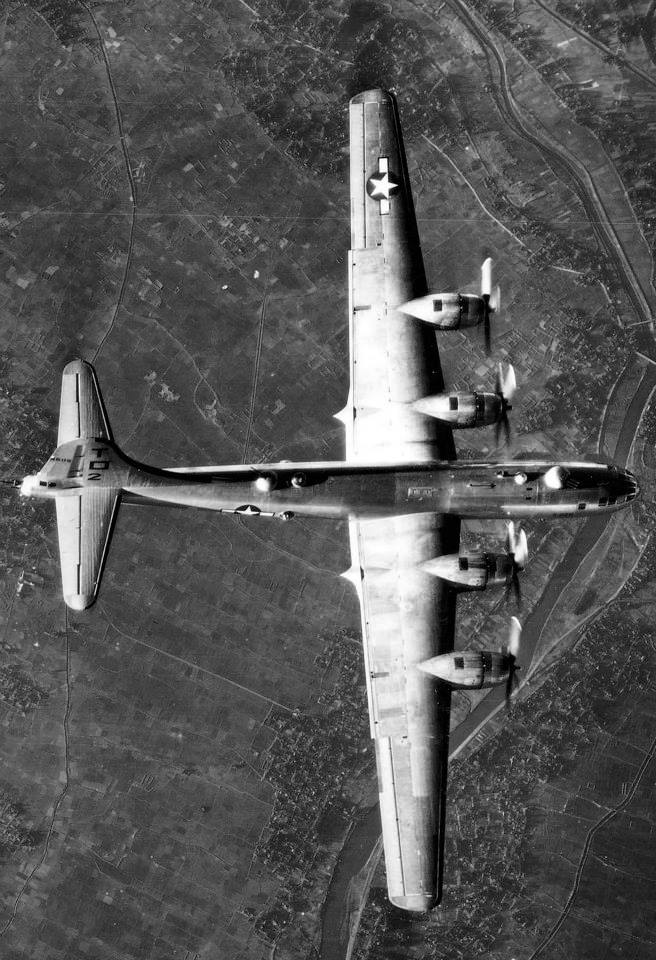 |
| World War II Aviation Photo. |
B29 Super Fortress of the type of heavy bomber that dropped the atom bomb.
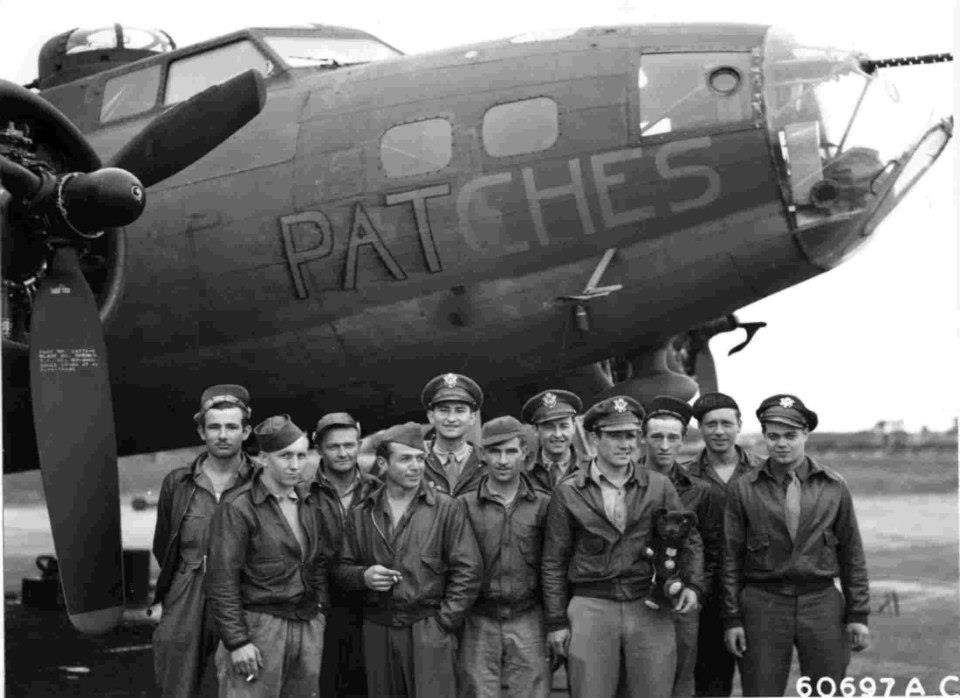 |
| World War II Aviation Photo. |
B-17 Flying Fortress and its crew. Crewmen went home after they had flown 30 missions, but most
didn't live that long.
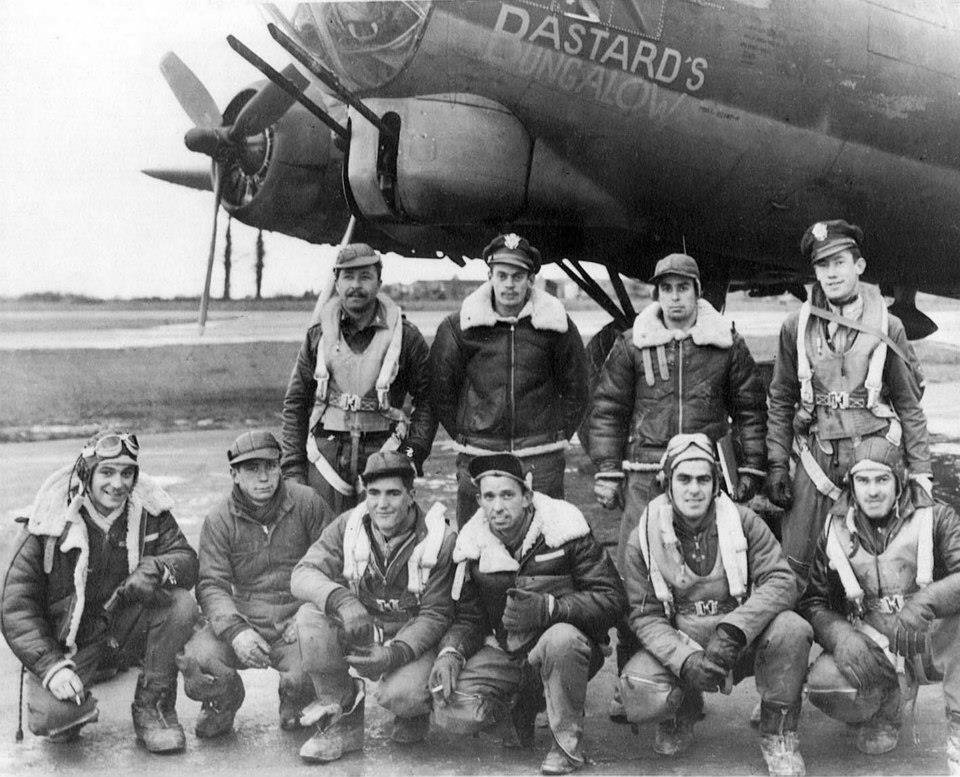 |
| World War II Aviation Photo. |
A B-17 Flying Fortress crew wearing warm clothing because the bomber wasn't pressurized and flying
at more than 30,000 feet where the temperature could be 60 degrees below zero, Fahrenheit.
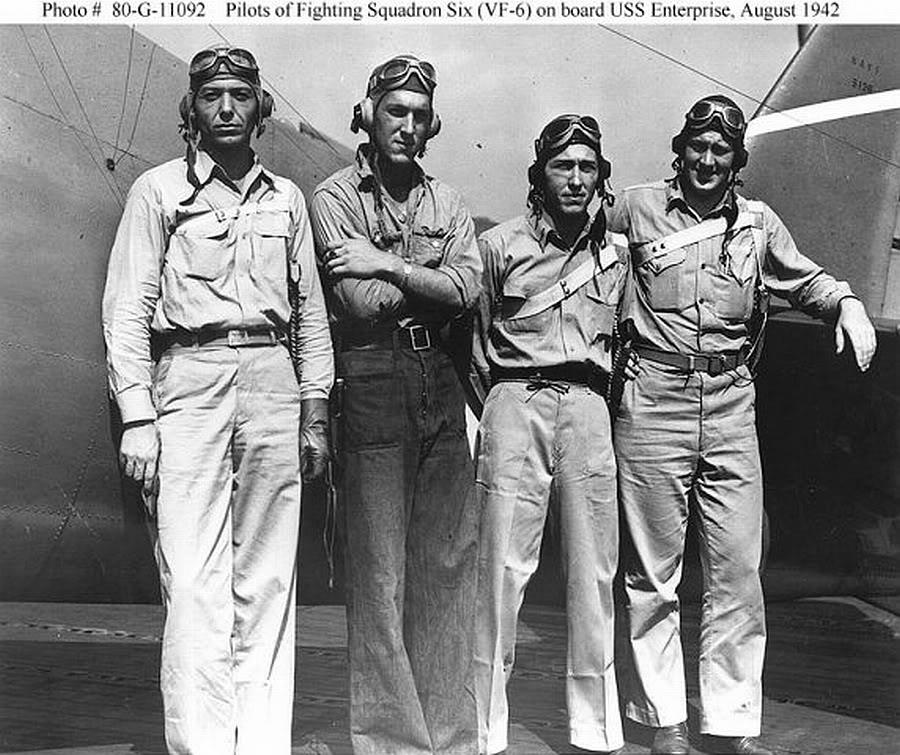 |
| World War II Aviation Photo. |
The picture has "Pilots of Fighting Squadron Six (VF-6) on board USS Enterprise, August 1942".
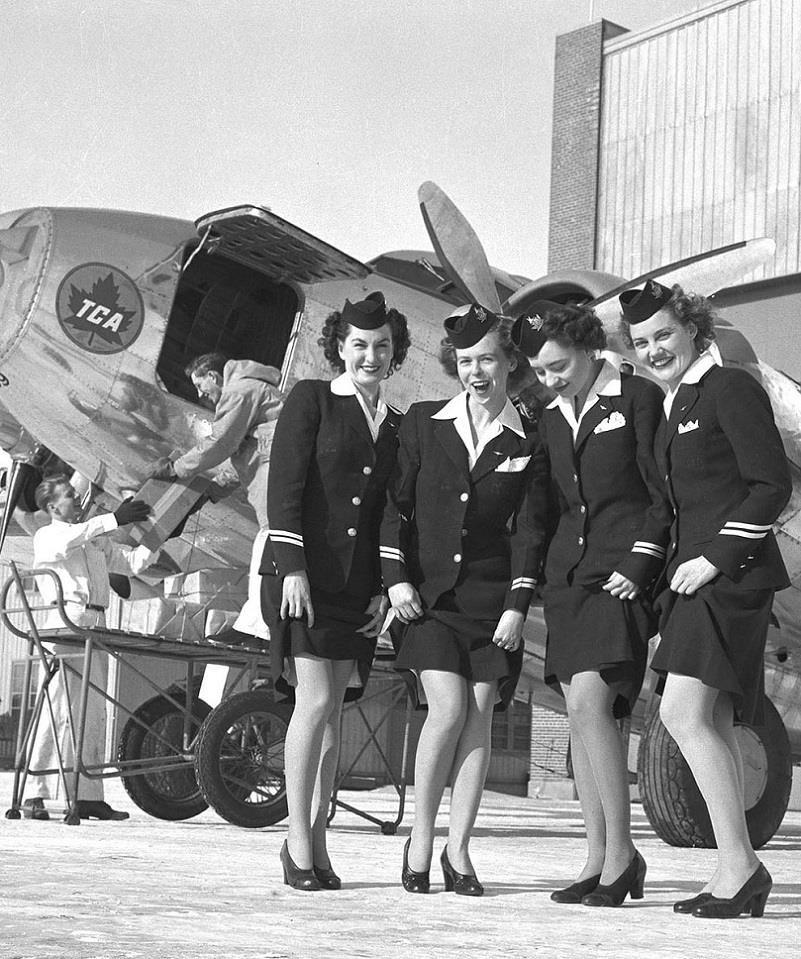 |
| World War II Aviation Photo. |
Trans-Canada Air Lines (also known as TCA in English, and Air Canada in French) was a Canadian
airline and operated as the country's flag carrier. Its corporate headquarters were in Montreal,
Quebec. Its first president was Gordon Roy McGregor. The airline operated under its original name
from 1937 to 1965, when it was officially renamed Air Canada.
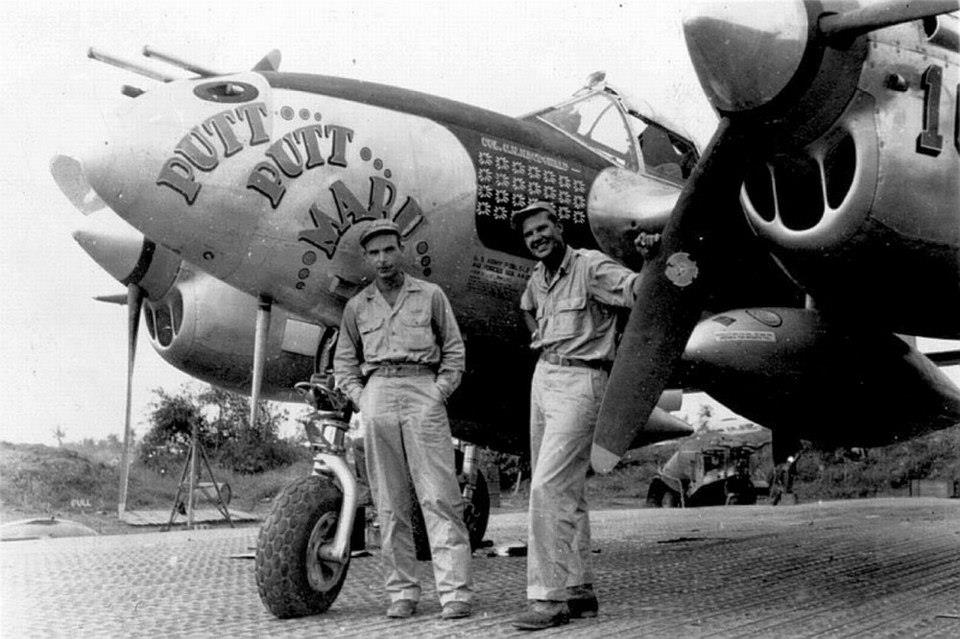 |
| World War II Aviation Photo. |
This is a Lockheed P-38 Lightning, a twin-engine fighter like the one that shot down Isoroku
Yamamoto on 18 April 1943. He was the commander-in-chief of the Japanese Combined Fleet during World War II, and a graduate of the Imperial Japanese Naval Academy.
To boost morale following the defeat at Guadalcanal, Yamamoto decided to make an inspection tour throughout the South Pacific. On 14 April 1943, the US naval intelligence effort, code-named "Magic", intercepted and decrypted a message containing specific details regarding Yamamoto's tour, including arrival and departure times and locations, as well as the number and types of planes that would transport and accompany him on the journey.
Yamamoto, the itinerary revealed, would be flying from Rabaul to Balalae Airfield, on an
island near Bougainville in the Solomon Islands, on the morning of 18 April 1943. U.S. President
Franklin D. Roosevelt ordered Secretary of the Navy Frank Knox to "Get Yamamoto."
Admiral William F. Halsey, Jr., Commander, South Pacific, authorized a mission on 17 April to intercept Yamamoto's flight en route and shoot it down. A squadron of USAAF Lockheed P-38 Lightning aircraft was assigned the task as only they possessed the range to intercept and engage. Select pilots from three units were informed that they were intercepting an "important high officer" with no specific name given.
Despite urgings by local commanders to cancel the trip for fear of ambush, Yamamoto's two Mitsubishi G4M bombers used as fast transport aircraft, without bombs, left Rabaul as scheduled
for the 315 mi (507 km) trip. Sixteen Lightnings intercepted the flight over Bougainville and a
dogfight ensued between them and the six escorting Mitsubishi A6M Zeroes.
First Lieutenant Rex T. Barber engaged the first of the two Japanese transports which turned out to be Yamamoto's plane. He targeted the aircraft with gunfire until it began to spew smoke from its left engine. Barber turned away to attack the other transport as Yamamoto's plane crashed into the jungle.
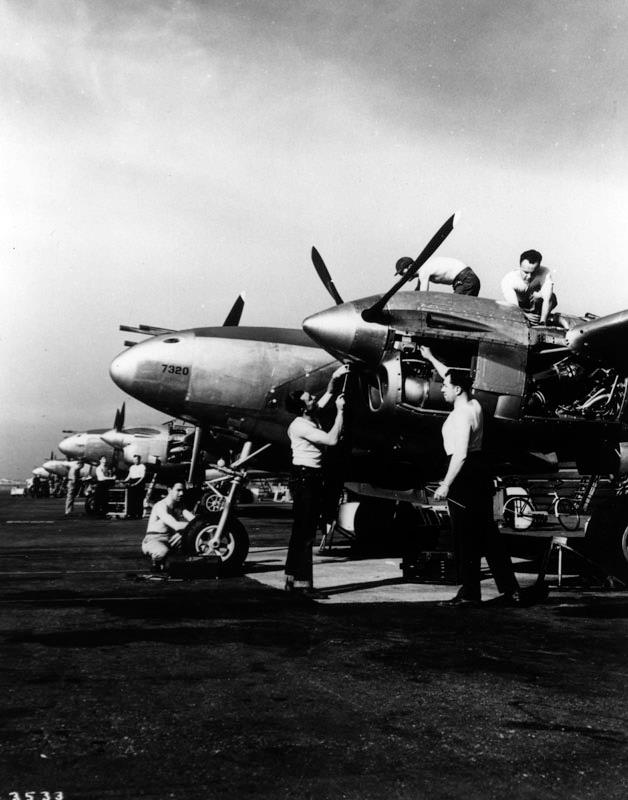 |
| World War II Aviation Photo. |
A row of P-38 Lightnings.
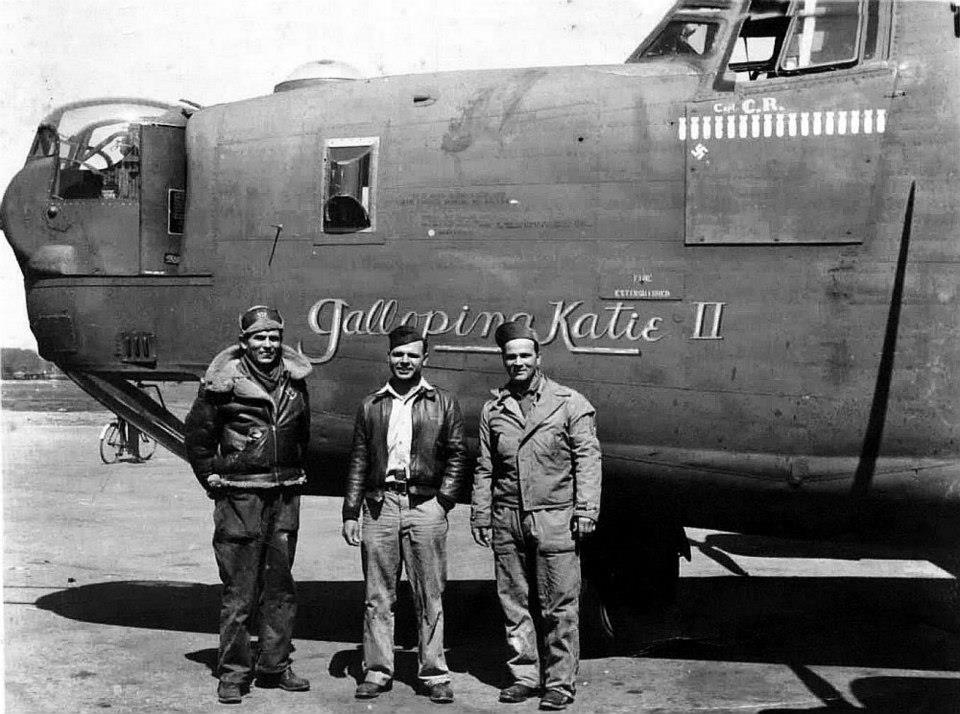 |
| World War II Aviation Photo. |
This is a bomber and some of its crew.
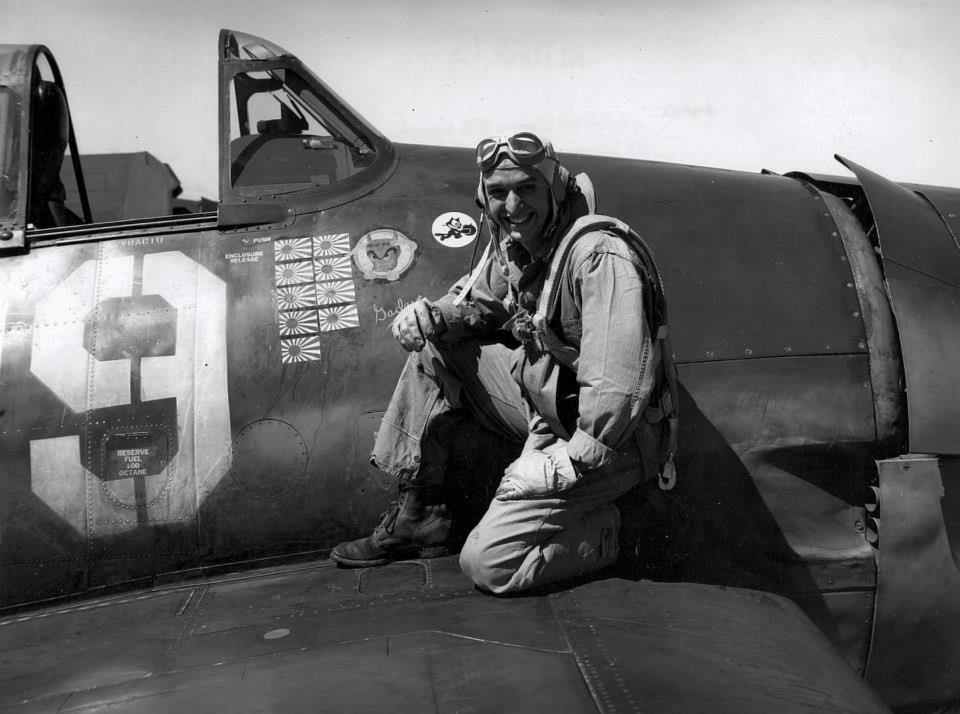 |
| World War II Aviation Photo. |
This guy is smiling because he is an ace (at least 5 kills) and one more kill will make him a
double ace. Note the painting of the cartoon cat, Felix, near his right cheek. That logo survived and was seen on Navy squadron as late as 2005.
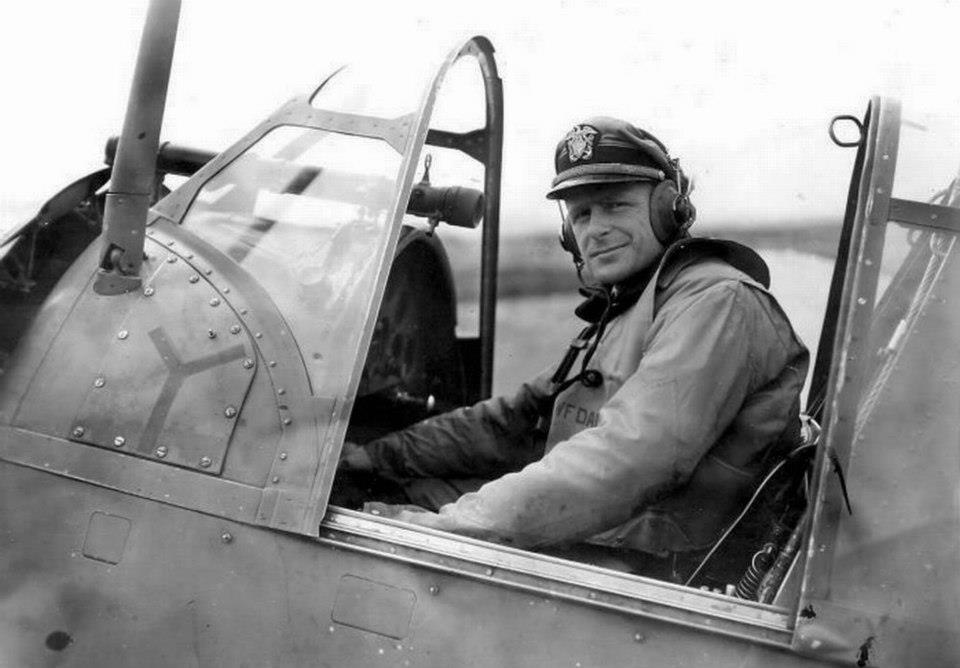 |
| World War II Aviation Photo. |
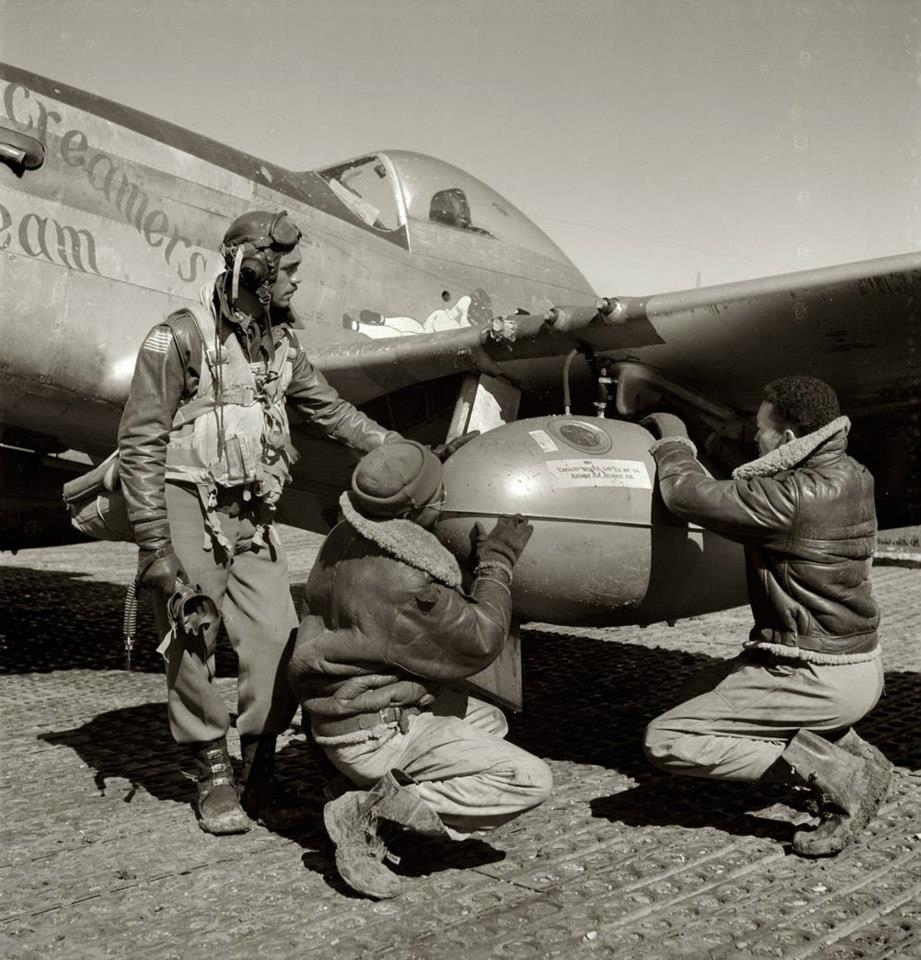 |
| World War II Aviation Photo. |
This is the famous North American Aviation P-51 Mustang. The pilot watches as the ground crew
checks a gas tank used to extend the plane's range. During the flight, when the tank was empty or a dog-fight was about to occur, the tank could be dropped. Hence, it was called a "drop tank".
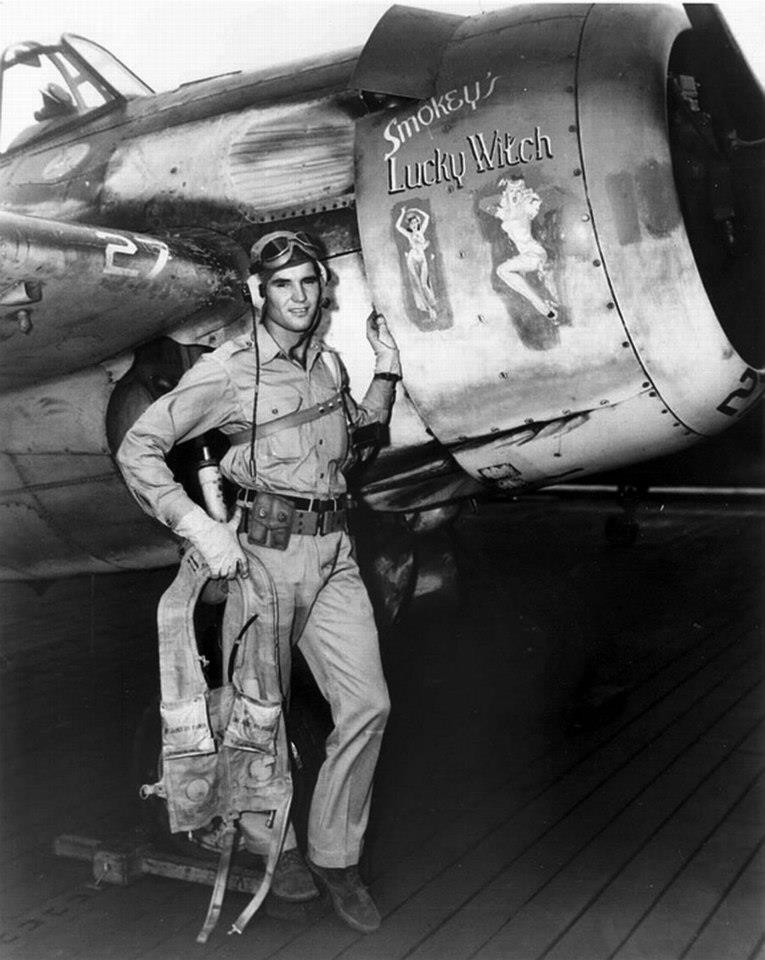 |
| World War II Aviation Photo. |
This Navy carrier pilot is holding his an inflatable life preserver and showing his plane's "nose
art" which was morale-booster during WWII. Nude or partially nude women were favorite subjects of
nose art.
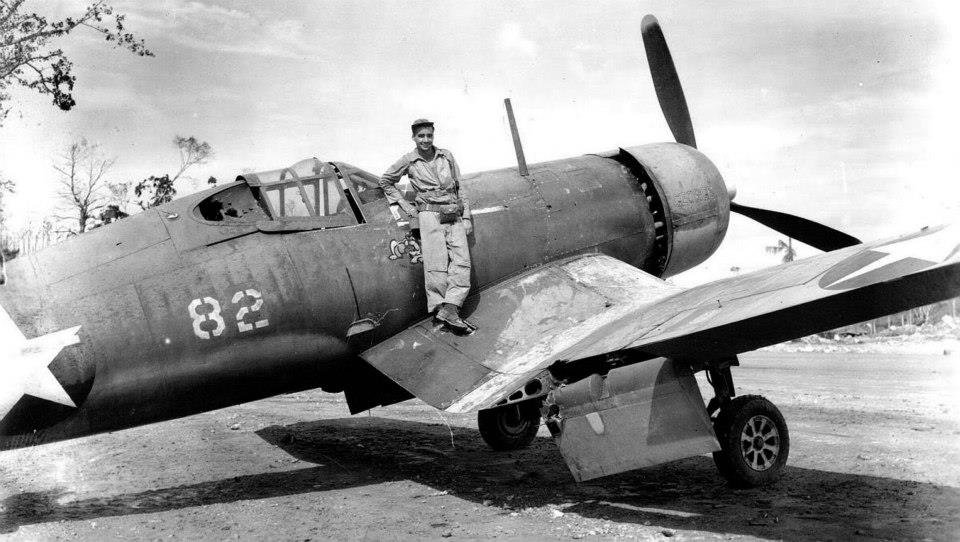 |
| World War II Aviation Photo. |
This is a Vought F4U Corsair that appears to have suffered battle damage. The Corsair had a long, radial-type engine with cylinders set in a helical around the crank case. Because of that design, to make the power plant more compact and aerodynamic, it was called a "corn cob" engine.
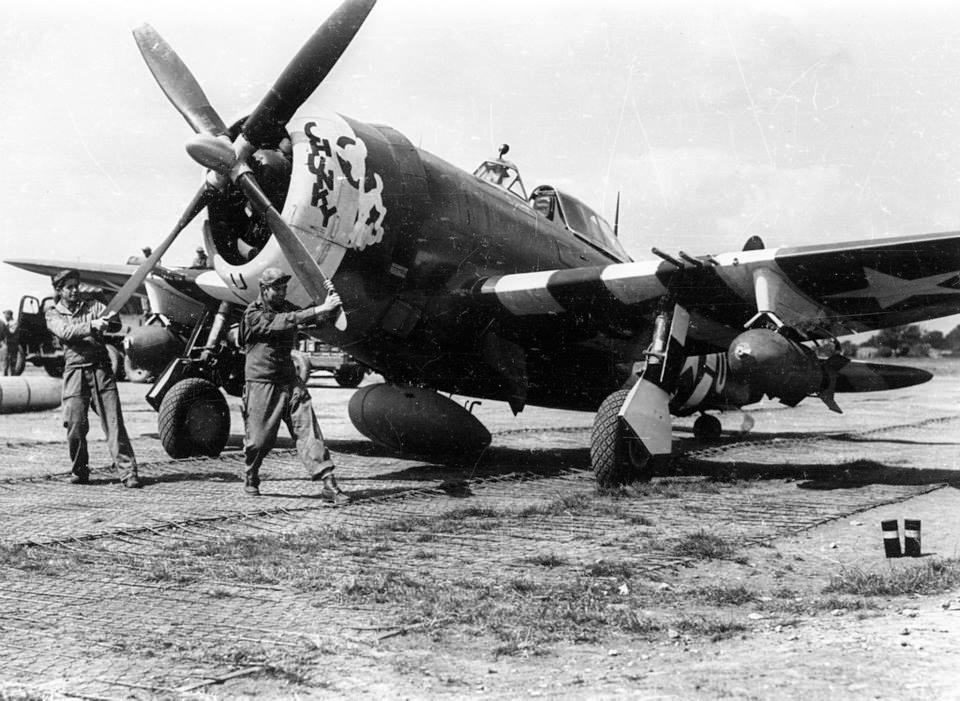 |
| World War II Aviation Photo. |
This is a Republic P-47 Thunderbolt with a centerline drop tank. The Thunderbolt was a heavy but capable plane with dual-role capability: fighter and bomber. After dropping its bomb, it could change to a fighter role.
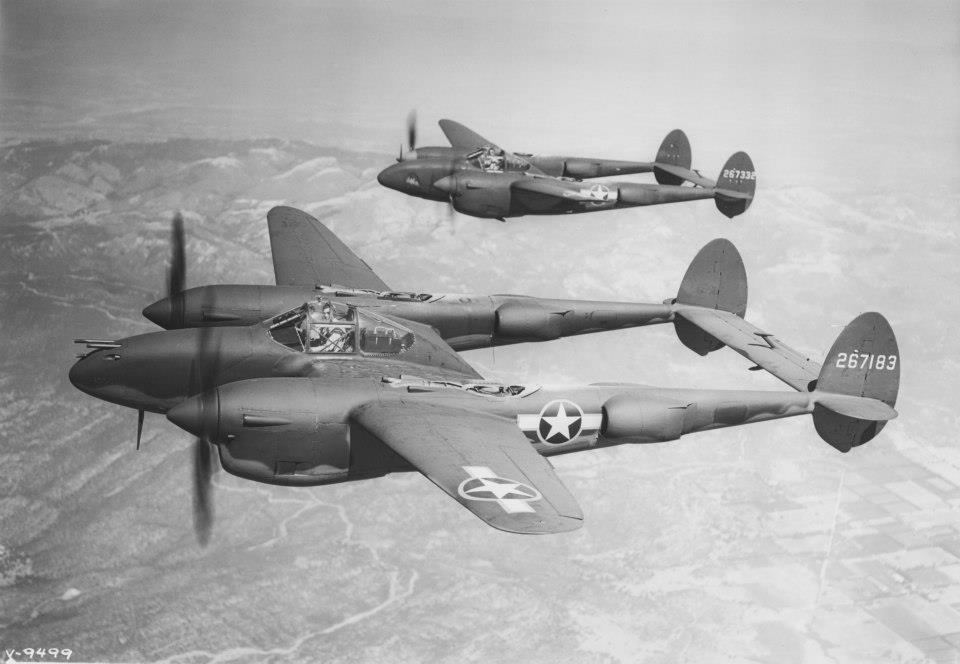 |
| World War II Aviation Photo. |
Two North American Aviation P-38 Lightnings flying formation. The enemy
called them "fork-tailed devils".
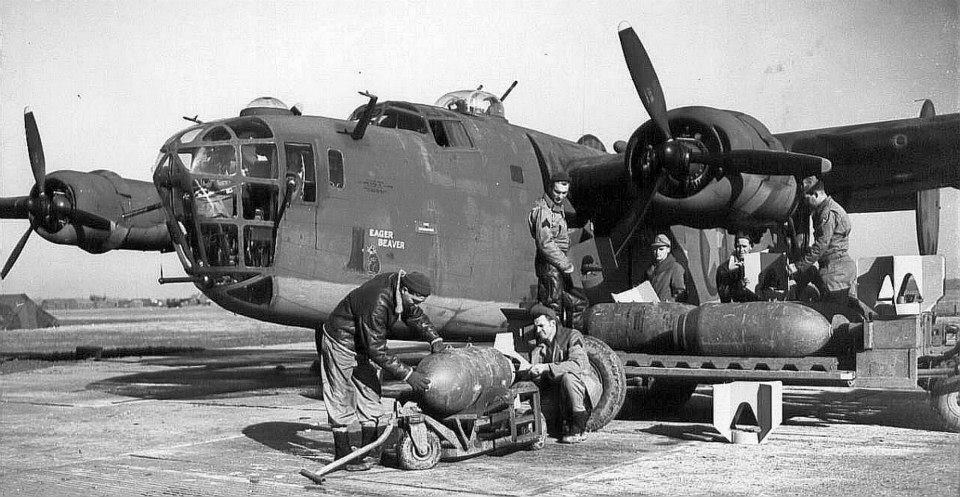 |
| World War II Aviation Photo. |
This ground crew is rearming a Consolidated B-24 Liberator bomber with bombs.
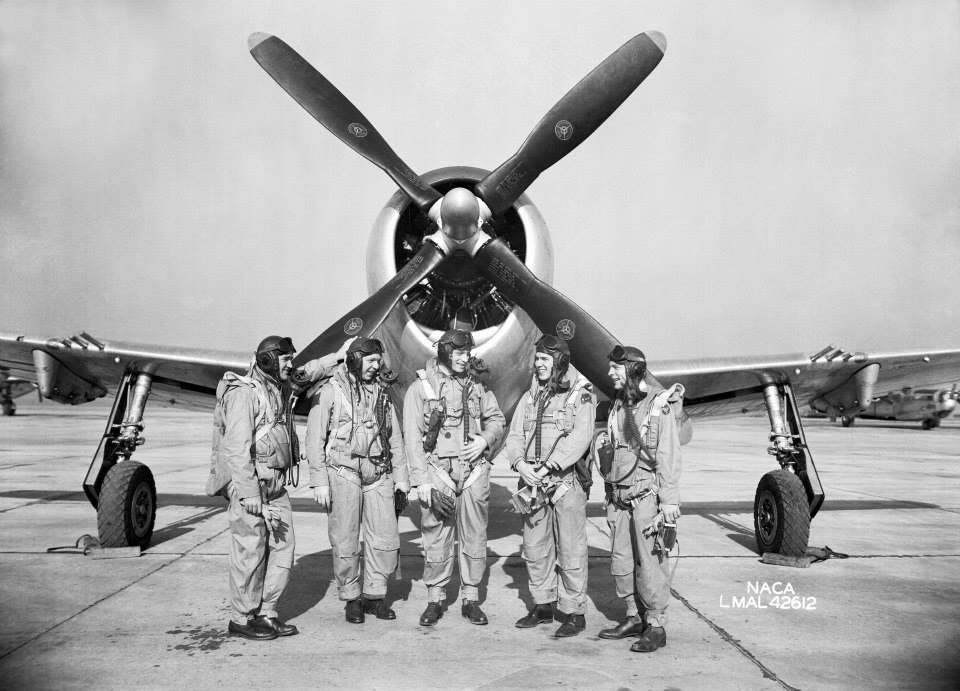 |
| World War II Aviation Photo. |
Pilots posing in front of a Republic P-47 Thunderbolt.
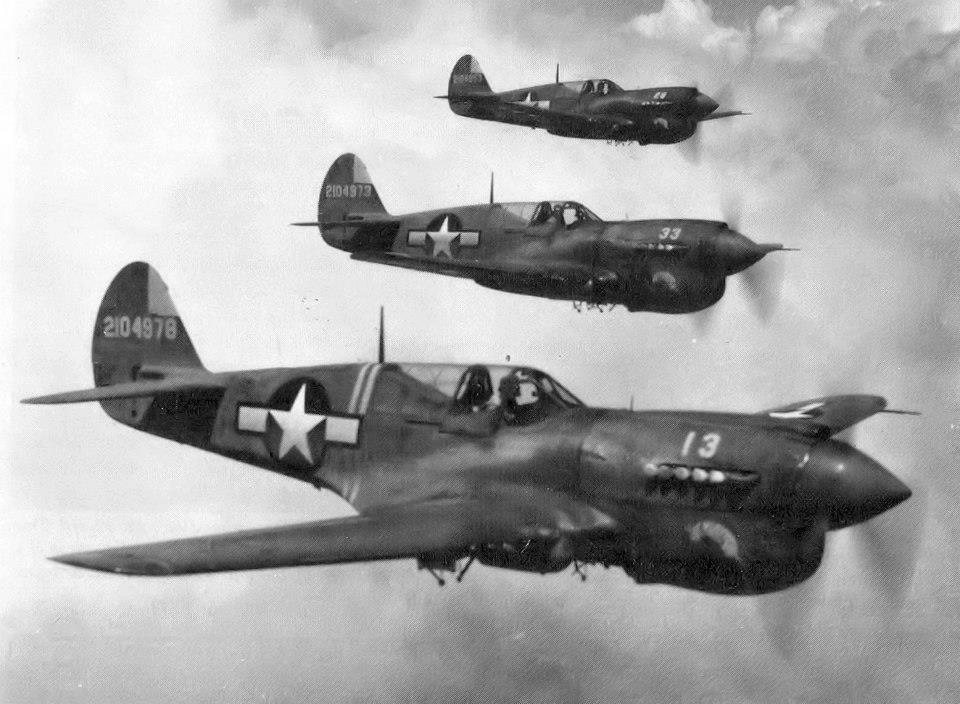 |
| World War II Aviation Photo. |
Three Curtiss P-40 Warhawks flying in formation.
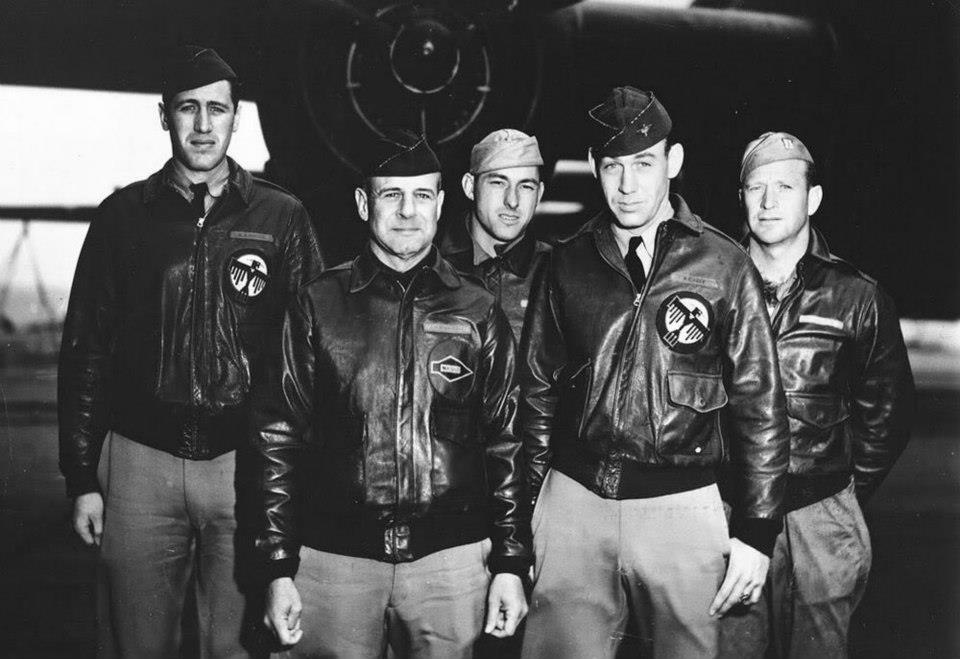 |
| World War II Aviation Photo. |
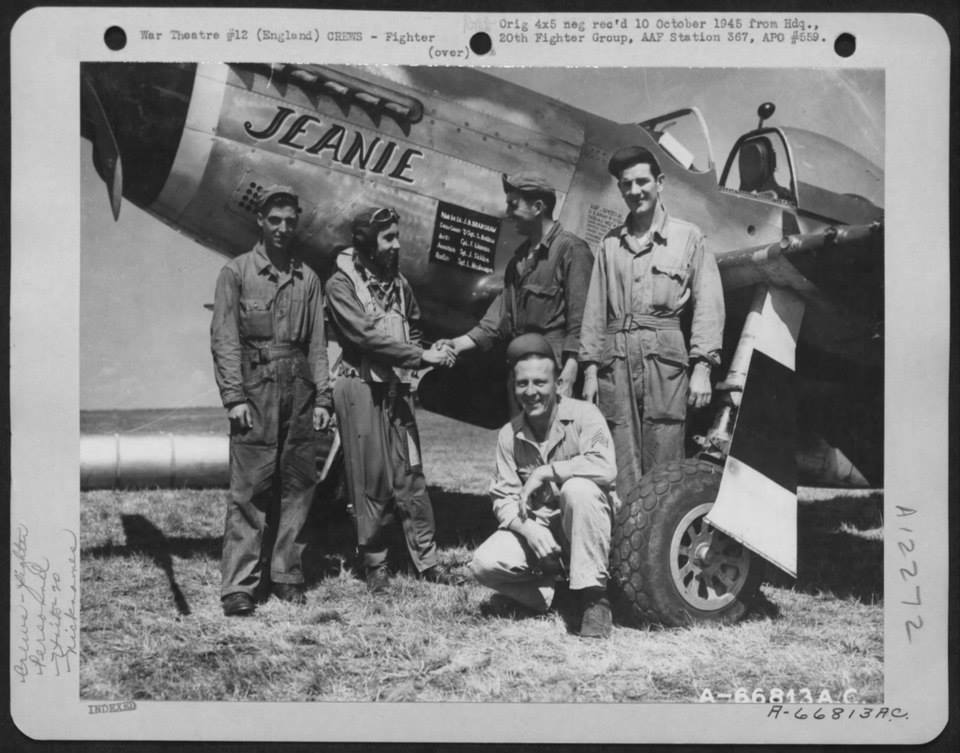 |
| World War II Aviation Photo. |
The pilot of this North American Aviation P-51 Mustang shakes the hand of one of the maintenance
crew. Pilots relied on the maintenance guys to keep their plane in good flying condition.
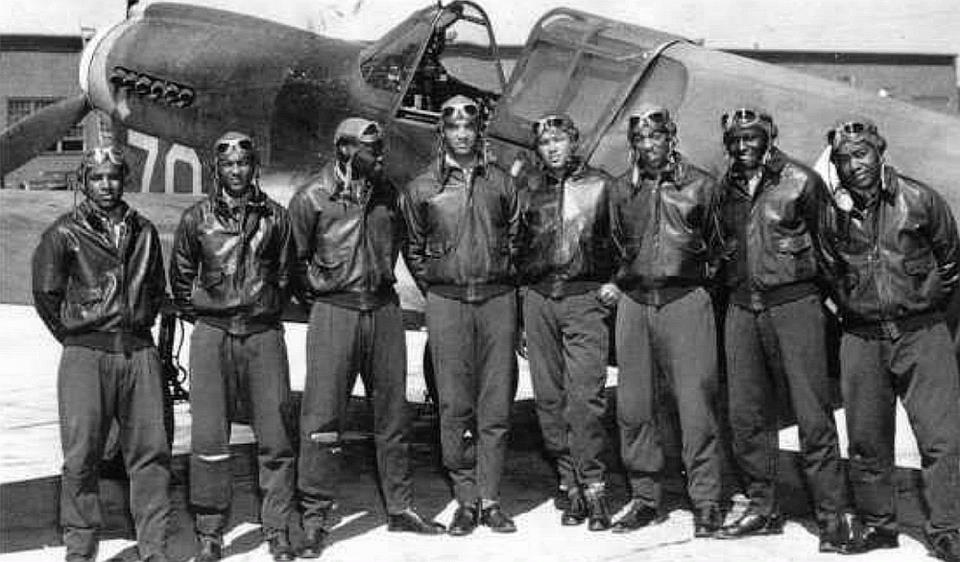 |
| World War II Aviation Photo. |
These blacks were called "Tuskegee Airmen" and were segregated from whites until after the war.
They fought spectacularly during WWII. This plane appears to be a Curtiss P-40 Warhawk.
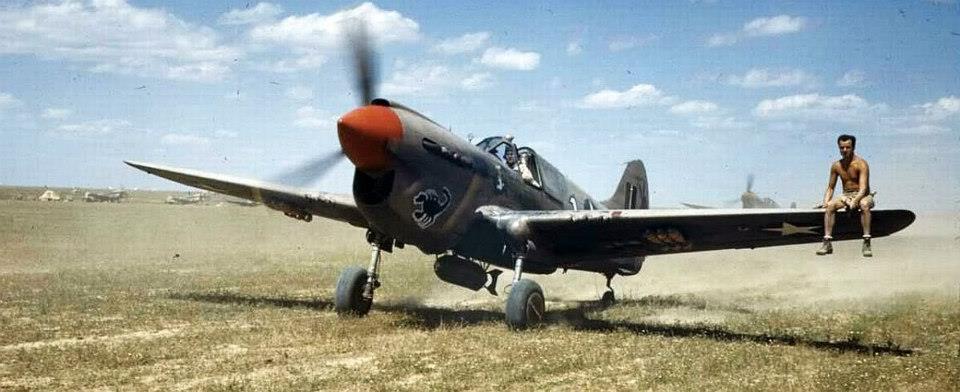 |
| World War II Aviation Photo. |
A person sits on the wing of a Curtiss P-40 Warhawk while it taxis. This was often done when a plane needed to be moved and there was a crosswind (in this case, from the plane's left side) that could flip the plane.
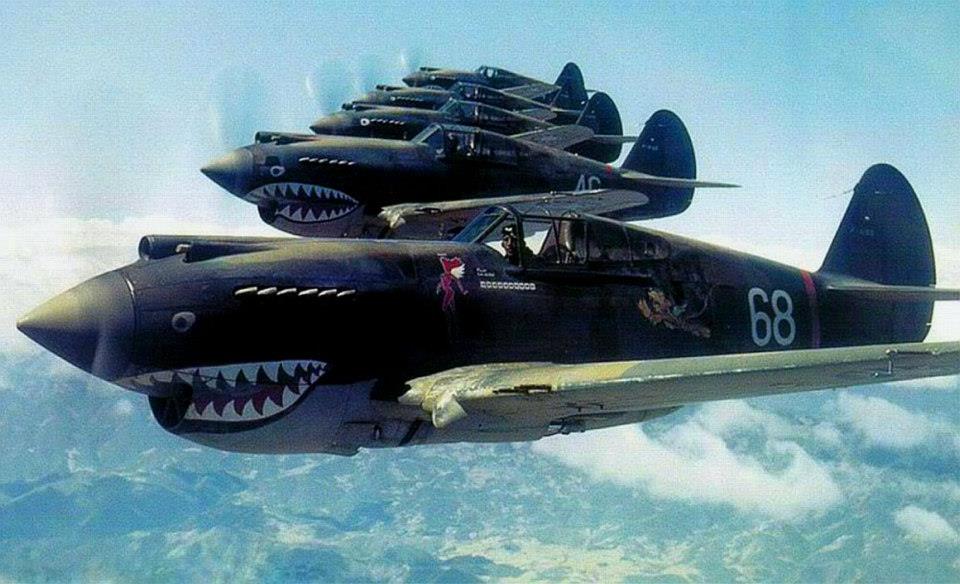 |
| World War II Aviation Photo. |
Five Curtiss P-40 Warhawks, or a variant, in formation.
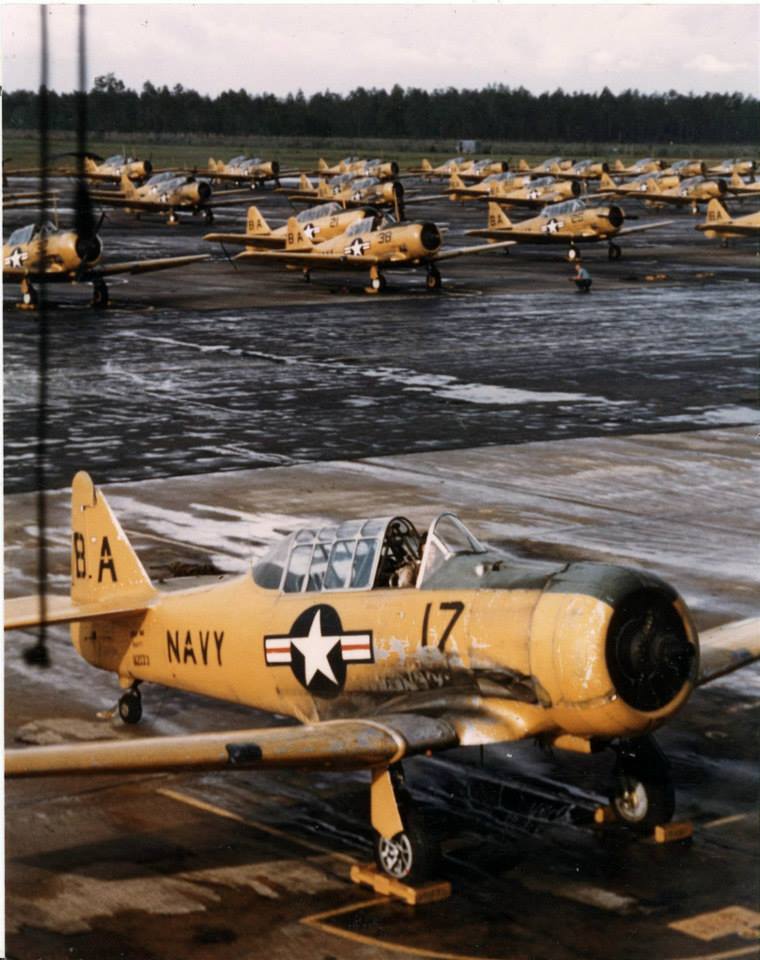 |
| World War II Aviation Photo. |
Navy WWII training planes at a ground base.
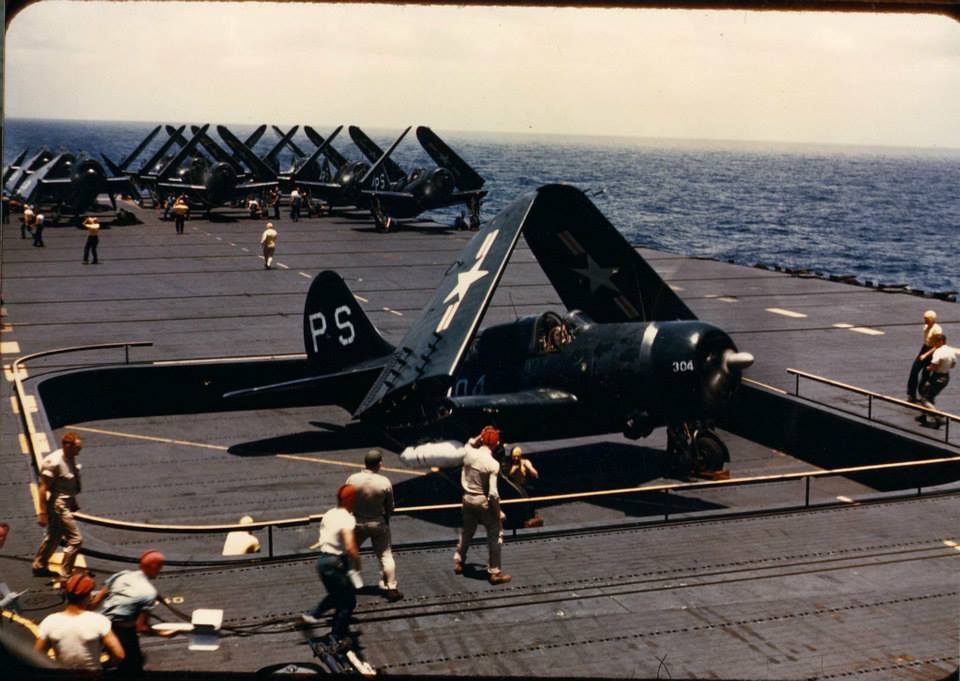 |
| World War II Aviation Photo. |
A carrier aircraft is lifted from below decks to the top deck on the elevator. Its engine is already running, ready to taxi as soon as the elevator is at the top and the barriers have dropped into slots in the deck.
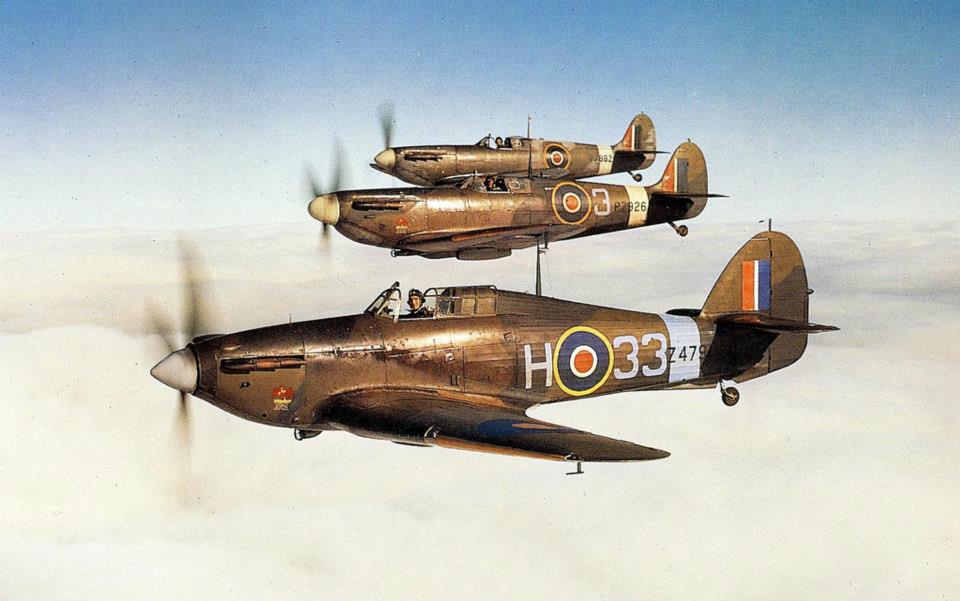 |
| World War II Aviation Photo. |
Three Hawker Hurricanes of the Royal Air Force (RAF) in formation.
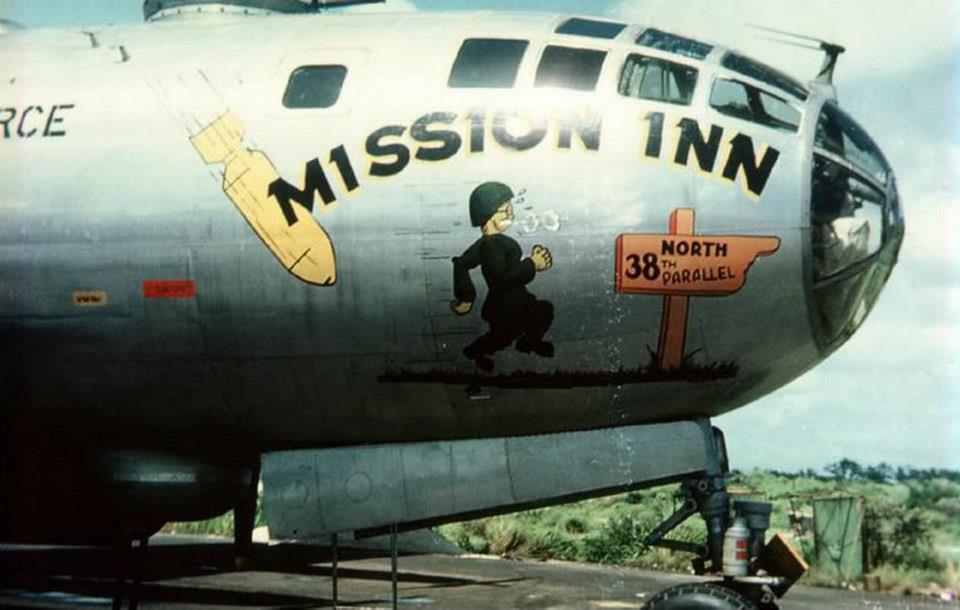 |
| World War II Aviation Photo. |
A Boeing B-29 Superfortress, a heavy bomber of the type that dropped the atomic bomb, probably
parked at an air base in Korea. The 38th Parallel was a key line of demarcation in North Korea.
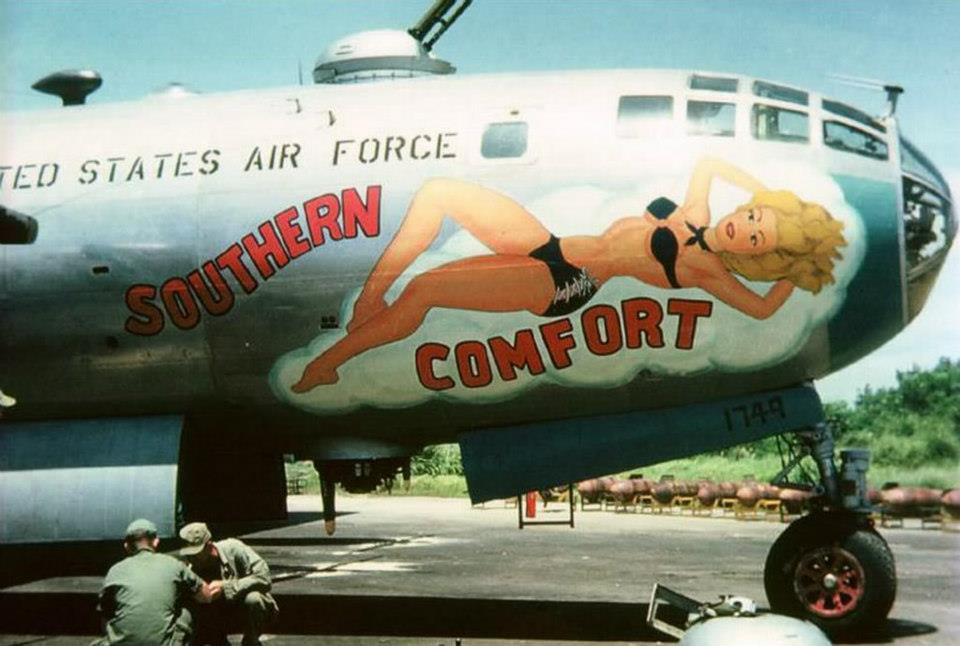 |
| World War II Aviation Photo. |
A Boeing B-29 Superfortress. Note the bombs in racks along the taxiway. The big nose allowed for super-size nose art.
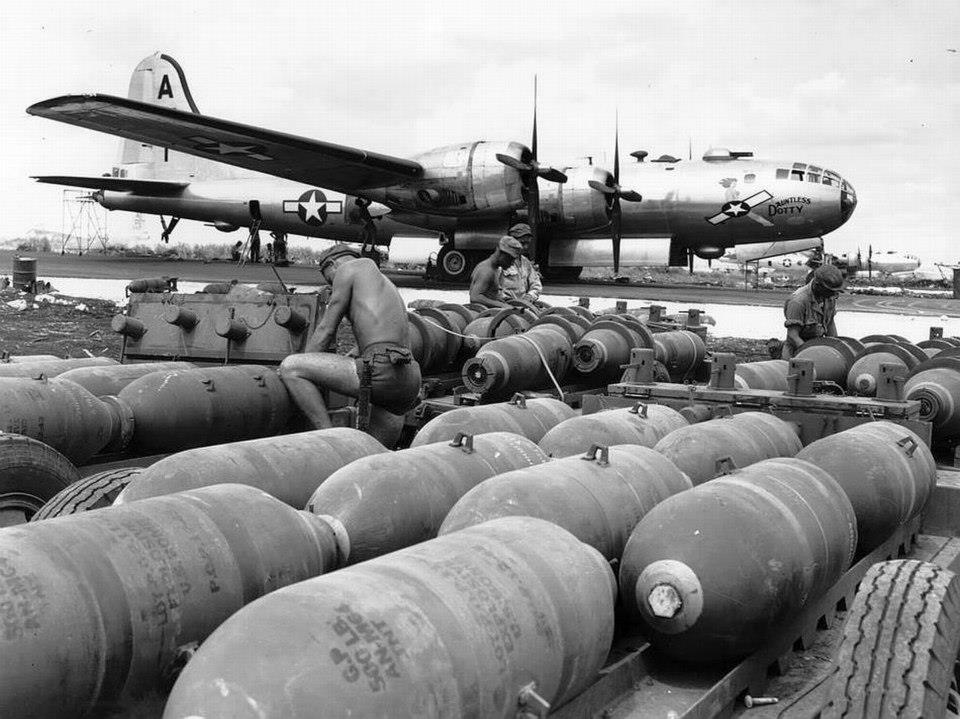 |
| World War II Aviation Photo. |
A Boeing B-29 Superfortress, probably at a remote Air Force Base. Armorers are preparing bombs to
be loaded.
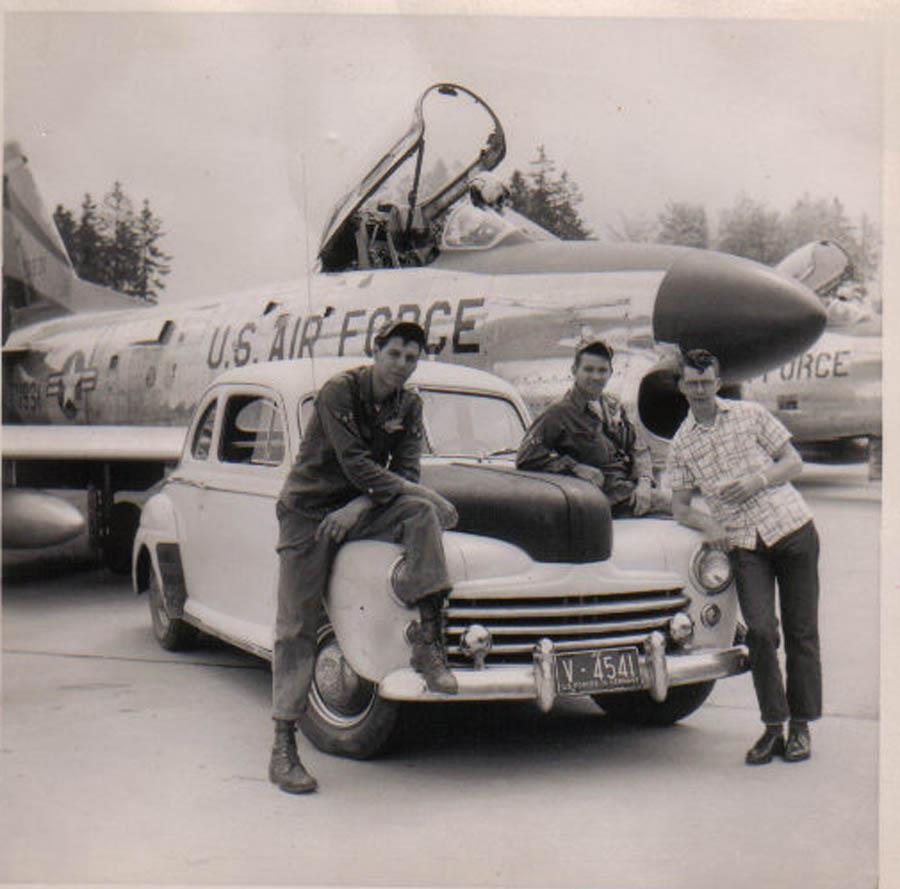 |
| World War II Aviation Photo. |
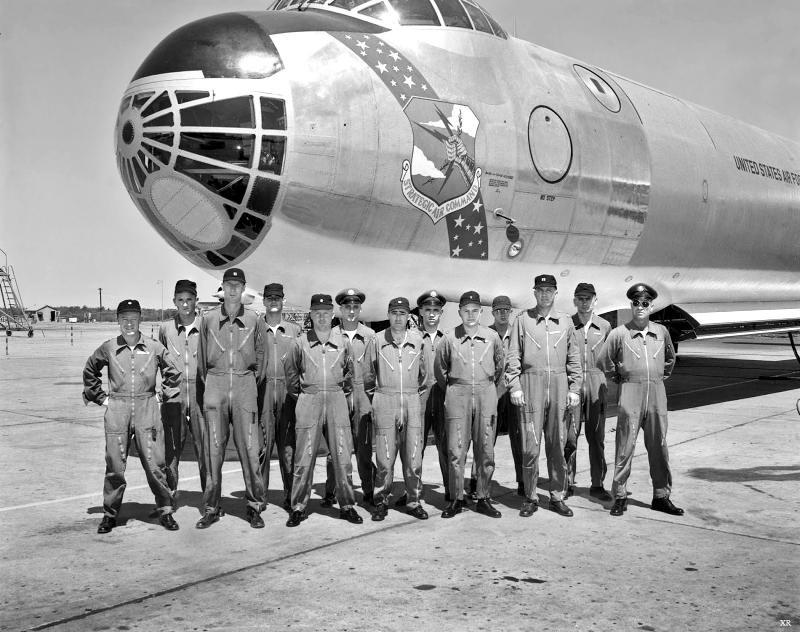 |
| World War II Aviation Photo. |
Crews posing with a Convair B-36 Peacemaker heavy bomber of the Strategic Air Command (SAC). It was a post WWII bomber and had 6 pusher engines and four jets, two near each wingtip. Because the engines propellers were on the back of the wing, behind the engine air intakes, the engines tended to overheat and catch fire.





































